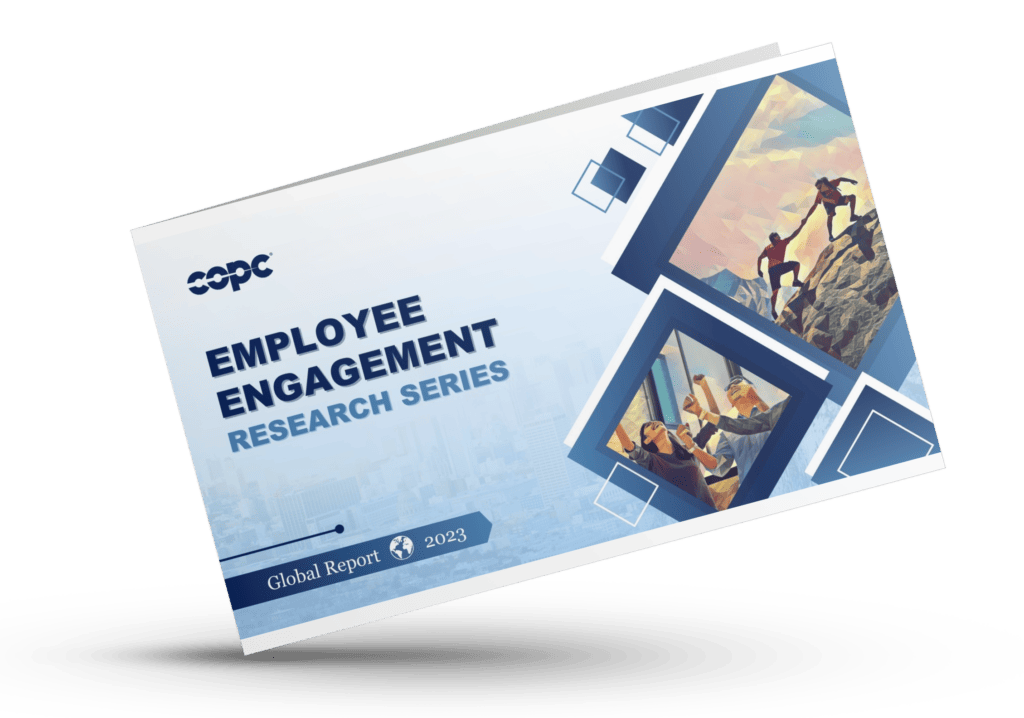Keeping employees engaged is a key challenge facing the customer experience industry, and few companies have developed effective approaches for ensuring engagement. Let’s look at what motivates and keeps workers in their current positions and why their enthusiasm is crucial to the individual workers and the business.
Remember that raising employee engagement is a journey, not a sprint. It calls for an all-encompassing, methodical strategy that considers each point of an employee’s experience working for the organization.
What is Employee Engagement?
Employee engagement refers to an employee’s emotional and mental commitment to work and organization. This goes beyond job satisfaction and involves dedication, passion, and loyalty, collectively enhancing productivity and business success. Engaged employees contribute to higher productivity, profitability, and customer satisfaction, as well as lower absenteeism and turnover rates.
| Employee Engagement: | This term describes how enthusiastic and committed a person is to their work and employer. Employees who are engaged are engrossed in their work, passionate about it, and proactive in advancing the goals and reputation of the company. |
Strong employee engagement offers undeniable benefits. Engaged employees are likelier to stay with the company, reducing turnover and creating a more experienced, committed staff. Additionally, greater worker productivity improves all aspects of the business, from safety and innovation to sales.
What then motivates this involvement? Effective leadership, transparent communication, chances for professional and personal development, prompt acknowledgment, and a work environment reflecting the workforce’s values are all important.
Impact of Employee Engagement
Employee engagement directly affects retention and turnover rates. Engaged employees are less likely to leave, creating a stable and experienced workforce. Regular measurement of engagement levels through surveys and discussions helps identify areas of improvement and maintain a responsive work environment.
Approximately 65% of workers worldwide report feeling engaged, indicating significant room for growth. Engagement varies greatly depending on the industry and region; it is not constant. For instance, participation is typically higher in Latin America and industries like services and technology. Numerous cultural and economic variables may be to blame for this, but there are factors we can manage to improve engagement, irrespective of geography or culture.

Employee Engagement Research Series
Learn how satisfied contact center staff are with their jobs, understand what drives employee satisfaction and distinguish the differences between countries.
Factors Influencing Employee Engagement
Several factors influence employee engagement, including:
Management and Leadership Styles
Effective leadership that motivates, guides, and supports employees is crucial. Workers look to their leaders for guidance and assistance. How executives lead, guide, and interact with their teams significantly impacts employee engagement.
Therefore, effective management and leadership are essential. Workers who believe their team leaders are trustworthy and accountable are three times more satisfied with their work and three times more inclined to stick with their companies.
Clear Communication
Transparency regarding roles, expectations, and organizational goals fosters a sense of community and purpose. Workers want to know what is expected of them, how their roles fit into the larger picture, and how much influence they have.
Since this openness creates a feeling of community and purpose, leaders’ conduct must reflect this knowledge of the organization’s goal. Open-door policies, team meetings, and frequent one-on-ones are all examples of effective communication techniques.
Opportunities for Growth
Providing avenues for professional development and career advancement keeps employees motivated. Workers are more engaged when they perceive a route for advancement and learning within the organization. This entails offering promotion chances, defined professional tracks, and training and development programs.
Leaders have a significant influence on the morale and retention of their teams by offering a variety of growth opportunities. In addition to being overseers, leaders also assist in learning and development. What steps have you and others taken to establish a culture encouraging ongoing learning and growth among your teams?
Recognition and Feedback
Regular acknowledgment of employee efforts and constructive feedback enhance job satisfaction and commitment. From a simple “thank you” to more official awards and honors, recognition can take many different forms. Managers must appreciate the value of acknowledging their team members’ contributions frequently. Only 74% of frontline staff think their team leaders appreciate their input.
On the other hand, work satisfaction triples, and employees are twice as likely to stick with the company when they believe their opinions are acknowledged. Frequent feedback should highlight areas for improvement and acknowledge and celebrate accomplishments.
Alignment with Company Values
Ensuring the organizational culture reflects the values and principles important to employees. Pay attention to the interactions and connections among the staff, particularly those involving social support, communication, teamwork, and dispute resolution.
Constructive dispute resolution and a mutually respectful culture promote cooperation and creativity, while supportive connections and effective communications can build a sense of belonging, enhance teamwork, and raise morale. When poor communication, unsolved disputes, or toxic relationships are detected, promptly fix them because they erode team member trust and lead to low staff engagement.
Effective leadership isn’t just about setting targets; it’s about inspiring, guiding, and supporting team members.
Steps for Creating an Effective Employee Engagement Strategy
Let’s review the procedures for designing a productive workstation supporting your company’s objectives.
- Assessment and Understanding: Examine the engagement level closely. Conduct focus groups, interviews, and surveys to learn about employees’ needs, goals, and areas of unhappiness.
- Define Clear Objectives: Based on the evaluation, establish specific, quantifiable goals that align with your company’s aims and your staff’s expectations. Whether your goals are increasing job happiness, decreasing turnover, or improving communication, they should align with general corporate objectives.
- Develop Targeted Initiatives: Make special efforts to deal with the areas that have been highlighted. This could include work-life balance initiatives, professional development plans, leadership training, and recognition programs.
- Communication: Ensure every employee understands and is aware of the engagement strategy. Goals, actions, and expected results must be transparent for involvement and buy-in.
- Implementation and Ownership: Assign accountability for every project. Getting managers and team leaders on board is essential since they are key players in increasing team engagement.
- Set Key Performance Indicators (KPIs): Create measures to assess how well your engagement campaigns work. These could include data from periodic pulse surveys, staff satisfaction ratings, productivity measures, and employee turnover rates.
- Regularly Review and Adjust: The engagement process is dynamic. Review your initiatives’ outcomes in relation to your KPIs regularly. Be ready to modify your plan in response to input and your employees’ changing demands.
- Celebrate Successes and Learn from Failures: To promote positive outcomes, acknowledge and celebrate when goals are met. On the other hand, when things don’t go according to plan, seize the chance to grow and improve your strategy.
Conclusion
Developing a solid strategy for employee engagement is a continuous process that calls for dedication, tolerance, and adaptability. You may cultivate a work environment that encourages engagement, productivity, and mutual success by evaluating current engagement levels, matching activities with corporate goals, and continuously monitoring and modifying your approach. Recall that a completely engaged staff is essential to organizational resilience and a strong driver of business performance.

Brent Jernigan, Director at COPC, brings over two decades of expertise in customer experience process improvement, specializing in performance improvement, quality systems and workforce management. Brent has led enhancement efforts across five continents, improving contact center performance in diverse industries such as technical support, hospitality, airlines and healthcare.
Noted for his ability to translate complex analytical concepts into everyday language, Brent is a highly sought-after training facilitator. His primary focus areas include contact center certification, business transformation and training.